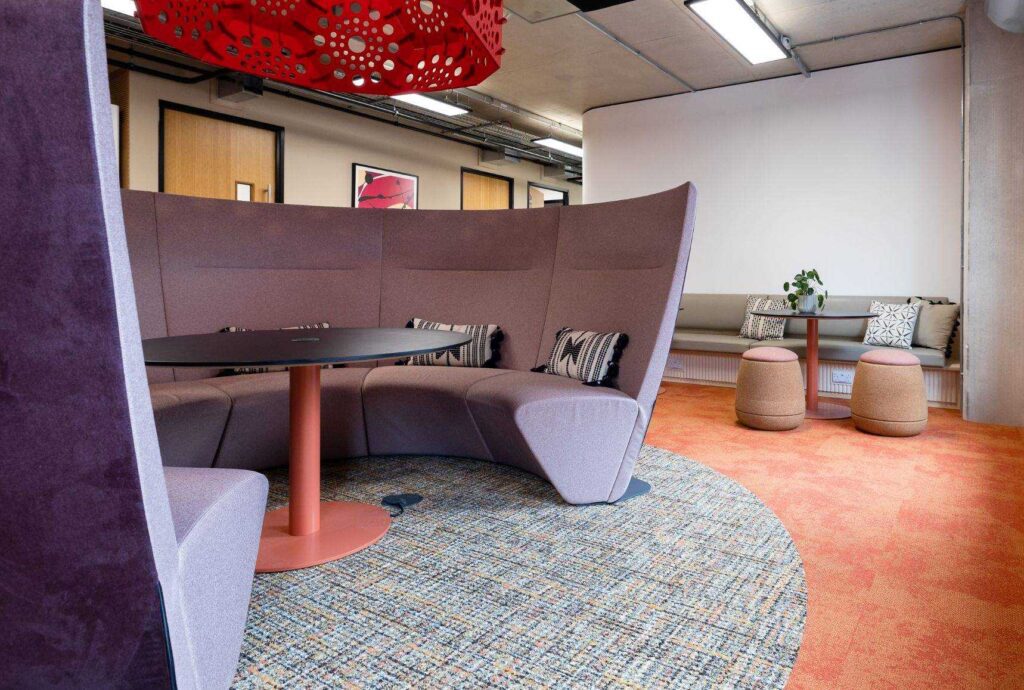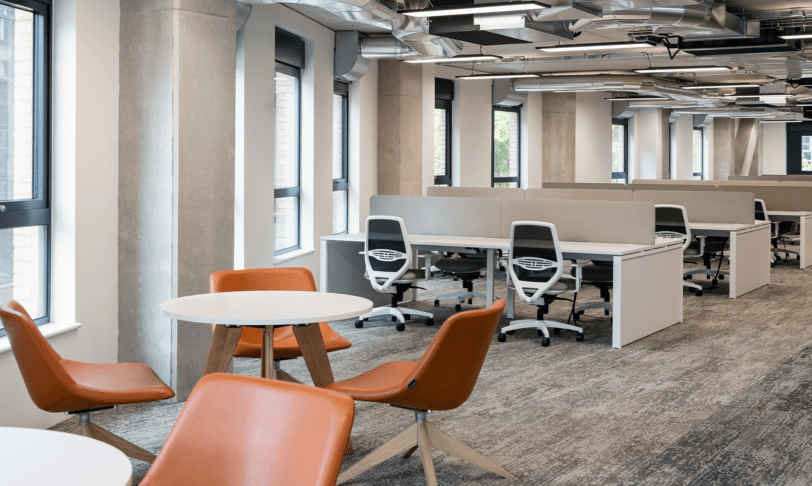Can colour really affect the way we work?
Creating a workspace that can potentially help with motivation, productivity and wellbeing is more important than ever.
Exploring the relationship between colour and mood
The average Brit will spend 84,365 hours at work during their lifetime, and with increasing numbers of employees returning to the workplace, businesses should strive to make their offices a welcoming environment. After all, the idea of returning to a gloomy office having previously worked from home isn’t exactly the most exciting prospect…
The study of how colours affect our moods, emotions and behaviours, commonly known as ‘colour psychology’ is a huge consideration for workplace designers. We all attach different feelings and emotions to colour and interestingly enough, colours can also have a range of physiological effects on the body.
The psychology of colour has been studied for years, with major figures using it in their works. For example, Nelson Mandela used the colour green to evoke feelings of hope and renewal during his political campaign to end apartheid in South Africa.
One of the first studies to explore the relationship between colour and mood was in 1979 by Schauss in a study of American prisons. It was found that aggressive behaviour decreased after walls were painted pink, which then became common practice in prisons across the U.S. and Canada. Over the years more and more businesses have incorporated colour psychology in their workplace design, with big-name examples including Google, Amazon, Zappos and Airbnb.
Colour in the workspace
It’s important to look at how psychological theories may have encouraged companies to implement certain colours into the workspace to improve productivity and wellbeing. Corporate giants like Google reportedly tested various colours around their office space to assess the effects of different colours. For example, it was found that purple had a negative impact on the work environment, as told by CBS.
Colour aficionados Dulux have, somewhat unsurprisingly, used their own paint colours to increase workplace wellbeing. Sonica Bucksteg, a colour expert at Dulux claims that “businesses should always consider the use of colour to promote a positive image, as well as to establish an environment where people will prosper”.
In our office designs we use colour in a multitude of ways. Whether it’s to separate departments or highlight features, we cannot overstate how colour choices can help bring a workspace to life. A great example of this is CPI Books, where the use of colour really transformed the office. Paying close attention to the details such as coloured screens, carpets and even painting the ductwork blue helped make it stand out.
In recent times, the change in how employee wellbeing presents itself has meant that employers must evolve the way in which their business operates and looks. When updating your office fit-out, think about the kinds of emotions you want to elicit and try to embed them in the overall process.
Office colours and behaviour
We delve into how different colours in the workplace can affect employees behaviour.

Office colours for productivity
Yellow: Encouraging creativity
Entrepreneur suggests that yellow is an optimistic colour that can help stimulate creativity, as well as increasing enthusiasm and mental clarity.
We feel that yellow really represents pure, unadulterated joy, and can have a valuable impact on your workplace culture. Here at Interaction we believe that culture is one of the most important parts of the workplace, and you can learn more about how we have achieved our brilliant one here.

Red: Stimulating activity
Red can be ideal for stimulating the brain. It can also increase heart rate and respiration rates as found in a study by The University of Texas. Dr. David Lewis supported this hypothesis after it was found that the colour red can increase tension. However, not all research supports this hypothesis. As reported by The Telegraph, red can actually be perceived positively by employees, and can be good for motivating people.
It’s best to keep red in small quantities, such as an accent wall or to draw the eye to key information. If not used sparingly, it can be quite overwhelming if not downright alarming.

White: Inspiring optimism
Aside from the usual connotations of cleanliness, simplicity and neutrality, white can also be used to inspire optimism by creating a sense of balance and harmony. This goes hand in hand with productivity, equipping employees with the confidence to achieve.
It is important to note that white space can make a space feel cold and uninviting when used in combination with cool colours. To make sure your office doesn’t come off too clinical, try to balance white with warm tones, textures and patterns to create a more welcoming and hospitable atmosphere.

Office colours for wellbeing
Blue: Enhancing mood
Blue comes out on top in Dr David Lewis’ study, naming it the all-round winner for enhancing mood and brain function. It can promote feelings of calm and tranquility while also stimulating the mind. The combination of these two feelings can encourage adaptability in working environments.
Due to its positive effects on focus and wellbeing, blue is ideal in settings where you need to get your head down, or where you may need to take some time away from your desk.

Green: Offering reassurance
For many people, green represents feelings of renewal and rejuvenation, so it is often used in break rooms, lounges and bathrooms. Green has a calming effect on the mind and body and is often found to reduce stress, making it a great consideration for individual workspaces.
If it didn’t do enough, green also promotes concentration so it is ideal for meeting rooms. While a pale green can create a sense of serenity, dark green has a luxurious effect, so it’s wise to consider what emotion you want to evoke when picking a shade.

Lavender: Soothing minds
Lavender is a popular colour choice in office design as it can create a restful, almost therapeutic atmosphere. It is often used as a secondary colour to complement whites, greys and blues, helping to create an air of wellbeing and relaxation.
Lavender is also a popular colour choice for conference rooms as it can improve focus, communication and clear-thinking. However, as it is a very subtle colour there is a risk of it appearing too pale or drab if it is not paired with more pronounced textures or patterns.

Keeping Colour Sustainable
Many paints contain volatile organic compounds (VOCs). At room temperature, VOCs can evaporate and emit gases linked to various health problems. It is important to select paints that have either a negligible amount of VOCs or ideally none at all. You should also avoid oil-based paints because of their high VOC content, as well as paint from old cans that may contain mercury or lead.
Space to thrive
At Interaction, we believe everyone should have a space in which they can thrive. That’s why we create some of the UK’s best workspaces, built to encourage positive behaviours at every level. If you’d like to enhance the way your company works, maybe it’s time you invested in an inspiring office design. Reach out on 01225 485600 or contact Charlie.
Join the Interaction community
Sign up for our newsletter to stay up-to-date with the latest insights
on the modern workplace and commercial property trends.



